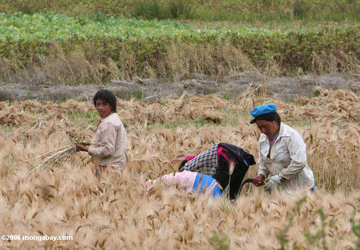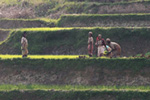The UN’s Food and Agriculture Organization (FAO) has warned that a drought in China could devastate the nation’s winter wheat crop and further inflate food prices worldwide. Already, food prices hit a record high in January according to the FAO. Rising 3.4 percent since December, prices reached the highest point since tracking began in 1990. While many fear a food crisis similar to the one in 2008-2007, experts say the world has more food in reserve this time around and gasoline, at least for now, remains cheaper. However, if China loses its winter wheat that could scuttle any hopes of avoiding another price rise in crop staples.
“Although the current winter drought has, so far, not affected winter wheat productivity, the situation could become critical if a spring drought follows the winter one and/or the temperatures in February fall below normal,” reads an FAO Early Warning on the situation.
Usually winter wheat is protected against frost by snow, but in China, low snow cover and little precipitation has left the wheat exposed. Approximately 60 percent of China’s planted wheat is imperiled due to the drought. If China loses the crop, analysts say the massive country, which is largely self-sufficient in food, will be forced to import grain to make up for the loss, threatening to upset an already precariously balanced international food market.
 Tibetans working in wheat field in China. Photo by: Rhett A. Butler. |
Wheat crops have already had a rough year: an unprecedented heatwave and drought in Russia and Eastern Europe raised wheat prices around 50 percent last year. Russia’s vast wheat yield was cut by nearly 40 percent and the country responded by placing a ban, which remains in place, on exporting wheat. Flooding in Australia has further raised concerns about wheat prices.
The extreme weather events, especially in Russia, have led to a number of experts to finger climate change as one cause behind this year’s rising food prices.
“I think we are seeing some of the early effects of climate change on food security,” Lester Brown, founder of the Earth Policy Institute told Public Radio International (PRI). “If someone had told me that there was likely to be a heat wave in Russia in which the average temperature would be 14 degrees Fahrenheit above the norm—that’s pushing the envelope. I mean FOUR degrees would be a lot.”
The FAO agrees, a report last November reads “adverse weather effects are undoubtedly a primary driver of wheat production shortfalls and, with climate change, may increasingly be so.”
In addition to climate change impacts, experts have pointed to a number of other reasons the world could see a second food crisis in three years, including use of food crops for biofuels, growing populations, fresh water shortages, rising meat and dairy consumption, the commodity boom, and soil erosion. Last time around, high oil prices played a big role, however, while oil prices are rising, they haven’t yet hit 2008 levels.
According to many analysts, high food prices have already played a part—albeit amid many other factors—in the social unrest in both Egypt and Tunisia. In addition, countries like Somalia are facing an all-out famine after rains also failed in East Africa. An estimated 2.5 million Somalians are currently requiring food assistance.
“In Somalia alone, water prices have increased as much as 300 percent in the past two months, and families are selling their assets and going into debt just to get clean water and food for their families,” said Chris Smoot, program director for World Vision in Somalia.
The UN estimates that 1 billion people in the world suffer from hunger, but the current food crisis could push that number higher.
Related articles
Numerous causes, including climate change, behind record food prices
(02/07/2011) Food prices hit a record high in January according to the UN’s Food and Agriculture Organization (FAO), threatening the world’s poor. Rising 3.4% since December, the FAO stated that prices reached the highest point since the agency began tracking food prices in 1990. Given the complexity of world markets and agriculture, experts have pointed to a number of reasons behind the rise including rising meat and dairy consumption, the commodity boom, fresh water scarcity, soil erosion, biofuels, growing human population, and a warming world that has exacerbated extreme weather events like last year’s heatwave in Russia.
‘Land grab’ fears in Africa legitimate

(01/31/2011) A new report by the International Institute for Environment and Development (IIED) has found that recent large-scale land deals in Africa are likely to provide scant benefit to some of the world’s poorest and most famine-prone nations and will probably create new social and environmental problems. Analyzing 12 recent land leasing contracts investigators found a number of concerns, including contracts that are only a few pages long, exclusion of local people, and in one case actually give land away for free. Many of the contracts last for 100 years, threatening to separate local communities from the land they live on. “Most contracts for large-scale land deals in Africa are negotiated in secret,” explains report author Lorenzo Cotula in a press release. “Only rarely do local landholders have a say in those negotiations and few contracts are publicly available after they have been signed.”
UN warns of likely food crisis next year for world’s poor
(11/17/2010) The Food and Agricultural Organization (FAO) warns in a new report that next year could see a rise in food prices, especially imperiling the world’s poor. The report predicts that food prices will jump 11% for the world’s poorest nations and 20% for low-income food-deficit countries. Already, the UN estimates that 1 billion people in the world suffer from hunger, the highest number in history.